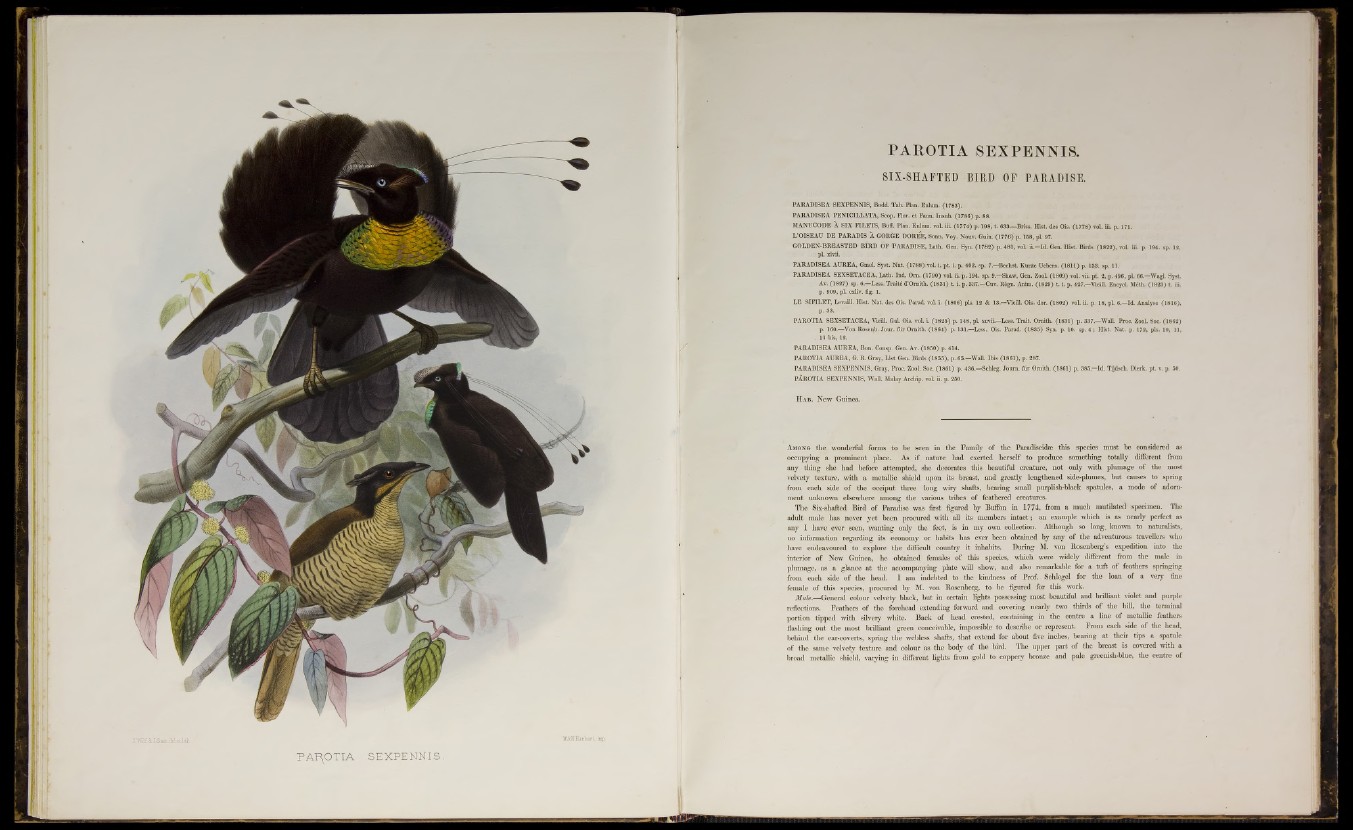
PAF\OTIA SHXPEXNIS
PAROTIA SEXPENNIS.
SIX-SHAFTED BIRD OF PARADISE.
PARADISEA SEXPENNIS, Bodd. Tab. Plan. Enlum. (1783).
PARADISEA PENlClLLATA, Scop. Flor, et Faun. Insub. (1 786) p. 88.
MANUCODE À SIX FILETS, Buff. Plan. Enlum. vol. ili. (1774) p. 198, t. 633.—Briss. Hist, des Ois. (1 778) vol. iii. p. 17l.
L’OISEAU DE PARADIS X GORGE DOREE, Sonn. Voy. Nouv. Guin. (1 776) p. 168, pi. 97.
GOLDEN-BREASTED BIRD OF PARADISE, Lath. Gen. Syn. (1 7 8 2 ) p. 481, vol. ii.—Id. Gen. Hist. Birds (1 822), vol. iii.. p. 194. sp. 12,
PARADISEA AUREA, Gmel. Syst. Nat. (1788) vol. i. pt. i.'.p. 402. sp. 7.—Bechst. Kurze Uebers. (1 811) p. 133. sp. 11.
PARADISEA SEXSËTACEA, Lath. Ind, Ora. (1 790) voli ii. p. 194. sp. 9.—Shaw, Gen. Zool. (1809) vol. vii. pt. 2,.p. 496, pi, 66.—Wagl. Syst.
Av. (1 8 2 7 ) sp. 6.—Less. Traité d’Omith. (1831) t . i . p. 337;—Cuv. Règn. Anim. (1829) t. i. p. 427.—'Viali. Encycl. Méth. (1 823) t. iii.
- p. 909, pl.' cxliv. fig. 1.
LE SIFILET, Levaill. Hist.- Nat. des Ois. Parad. vol. i. (1806) pis. 12 & 13.—Vieill. Ois. dor. (1 802) vol. ii. p. 18, pl. 6.—Id. Analyse (1816),
p. S3. ' “ "
PAROTIA SEXSETACEA, Vieill. Gai. Ois. vol. i. (1 8 2 5 ) p. 148, pl. xcvii.—Less. Trait. Ornith. (1831) p. 337.—Wall. Proc. ZooL Soc. (1862)
p. 160.—Von Roseqb. Jour, für Ornith. (1 864) p. 131.—Less. Ois. Parad. (1 836) Syn. p. 10. sp. 4 ; Hist. Nat. p: 172, pis. 10, 11,
. 11 bis, 12.
PARADISEA AUREA, Bon. Consp. Gen. Av. (I8 6 0 ) p. 414.
PAROTIA AUREA, G. R. Gray, List Gen. Birds (1 855), p. 65.—Wall. Ibis (1 861), p. 287.
PARADISEA SEXPENNIS, Gray, Proc. Zool. Soc. (1 861) p. 436.—Schleg. Joum. fur Ornith. (1 861) p. 385.—Id. Tijdsch. Dierk. pt. v. p. 50.
PAROTIA SEXPENNIS, Wall. Malay Archip. vol. ii. p. 250.
Hab. New Guinea.
A m o ng the wonderful forms to be seen in . the Family of the Paradiseidse this species must be considered as
occupying a prominent place. As if nature had exerted herself to produce something totally different from
any thing she had before attempted, she decorates this beautiful creature, not only with plumage of the most
velvety texture, with a metallic shield upon its breast, and greatly lengthened side-plumes, but causes to spring
from each side of the occiput three long wiry shafts, bearing small purplish-black spatules, a mode of adornment
unknown elsewhere among the various tribes of feathered creatures.
The Six-shafted Bird of Paradise was first figured by Buffon in 1774, from a much mutilated specimen. The
adult male has never yet been procured with all its members intact; an example which is as nearly perfect as
any I have ever seen, wanting only the feet, is in my own collection. Although so long., known to naturalists,
no information regarding its economy or habits has ever been obtained by any of the adventurous travellers who
have endeavoured to explore the difficult country it inhabits. During M. von Rosenberg’s expedition into the
interior of New Guinea, he obtained females of this species, which were widely different from the male in
plumage, as a glance at the accompanying plate will show, and also remarkable for a tuft o f feathers springing
from each side of the head. I am indebted to the kindness of Prof. Schlegel for the loan o f a very fine
female o f this species, procured by M. von Rosenberg, to be figured for this work.
Male.—General colour velvely black, but in certain lights possessing most beautiful and brilliant violet and purple
reflections. Feathers of the forehead extending forward and covering nearly two thirds of the bill, the terminal
portion tipped with silvery white. Back of head crested, containing in the centre a line of metallic feathers
flushing out the most brilliant green conceivable, impossible to describe or represent. From each side of the head,
behind the ear-coverts, spring the webless shafts, that extend for about five inches, bearing at their tips a spatule
of the same velvety texture and colour as the body of the bird. The upper part of the breast is covered with a
broad metallic shield, varying in different lights from gold to coppery bronze and pale greenish-blue, the centre of